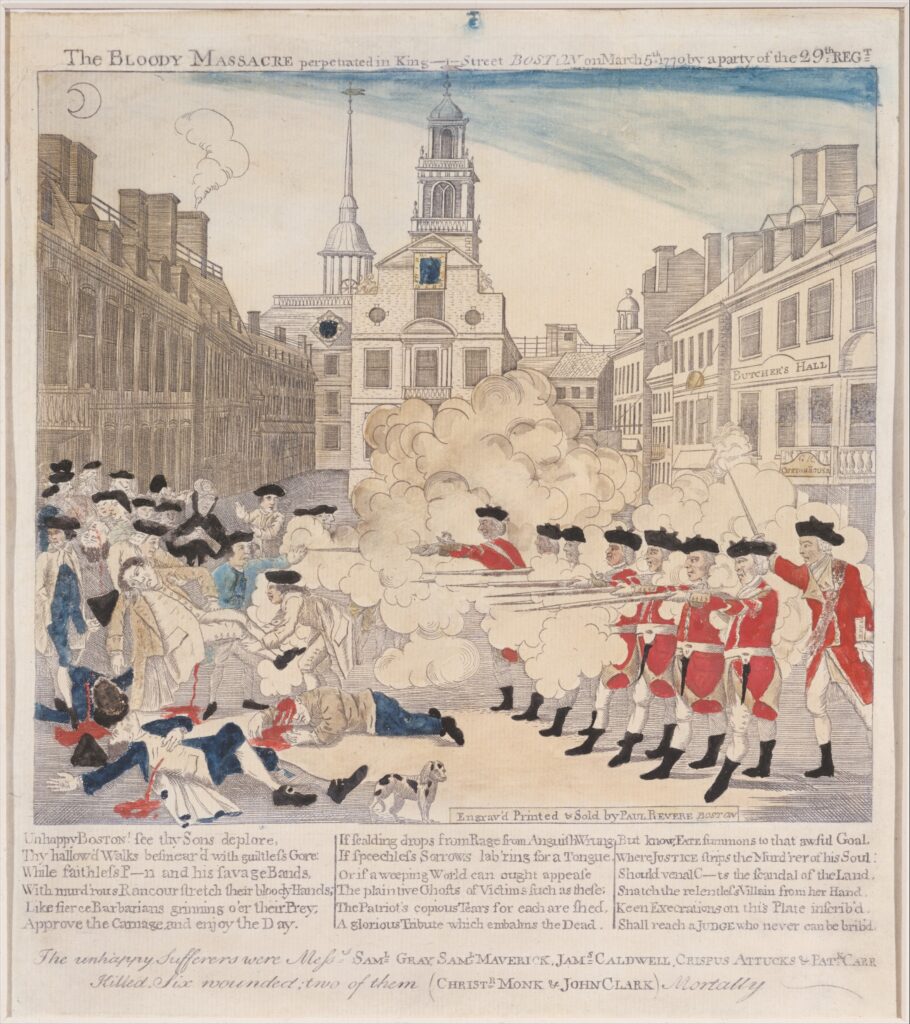March 5, 1770. A group of nine British soldiers shot five people in a crowd. The event came to be known as the Boston Massacre.
On the evening of March 5, Private Hugh White was on guard duty outside the Boston Custom House; also there was Captain-Lieutenant John Goldfinch. Soon after their arrival, a thirteen-year-old wig apprentice named Edward Garrick called out to Goldfinch and accused him of refusing to pay a bill owed to Garrick’s master. As it turns out, Goldfinch settled the bill the day before, and the young man did not know that. The pair exchanged smack talk, and Private White informed the young man that he should be more respectful to the officers. Garrick decided that the best course of action was to poke Goldfinch in the chest, which caused White to challenge the boy and then strike him in the head with his musket. Garrick cried out in pain, and one of his companions began to argue with Private White, attracting a larger crowd.
Threats began to be exchanged, including one from a bookseller named Henry Knox, who told White, “if he fired, he must die for it.”[1] It did not take long for a huge crowd to gather. More than fifty Bostonians gathered around White, taunting and arguing with him. The group was led by a former slave named Crispus Attucks. The crowd began throwing objects of various sizes and continued to grow larger.
Captain Thomas Preston was informed of the situation and dispatched a non-commissioned officer and six privates to relieve White with fixed bayonets. Preston, Corporal William Wemms, Private Hugh Montgomery, John Carroll, William McCauley, William Warren, and Matthew Kilroy arrived at the scene shortly after. While there, Henry Knox grabbed Preston by the coat and told him, “For God’s sake, take care of your men. If they fire, you must die.” Preston responded with a simple, “I am aware of it.”[2]
The soldiers loaded their muskets and arranged themselves in a semi-circular formation. By then, the crowd was between three hundred and four hundred people.
In the span of a few minutes, pressure began to grow exponentially. The crowd haunted the soldiers with yells of “Fire!”[3] They also began spitting at them, throwing snowballs and other objects. One of the objects hit Private Montgomery with such force that he was knocked to the ground and dropped his musket. When he recovered, he angrily shouted, “Damn you, fire!”[4] He then discharged his musket into the crowd.
After the shot was fired, innkeeper Richard Palmes swung his club at Montgomery and then Preston. But he’s not. After this, there was reported to be a pause, although no one knows how long that pause lasted; some say seconds, while others say minutes. After the pause, soldiers fired into the crowd. Preston still had not given any orders to fire.
The gunfire hit eleven men; three died instantly. Samuel Gray, a ropemaker, James Caldwell, a mariner, and Crispus Attucks all died at the scene. A seventeen-year-old apprentice named Samuel Maverick would die the following day. Patrick Carr, an Irish immigrant, died two weeks later.
The crowd dispersed only after Acting Governor Thomas Hutchinson was summoned to the scene and promised that a fair inquiry into the shootings would happen if the crowd left. Patriots like Paul Revere and Samuel Adams would widely publicize the event as “a massacre,” fueling the flames for a revolution.

[1] Robert J. Allison, The Boston Massacre, (Beverly, MA: Applewood Books, 2006), 11.
[2] Hiller B. Zobel, The Boston Massacre, (New York: W.W. Norton & Company, 1970), 195.
[3] Hiller B. Zobel, The Boston Massacre, p. 197.
[4] Ibid.

Leave a Reply